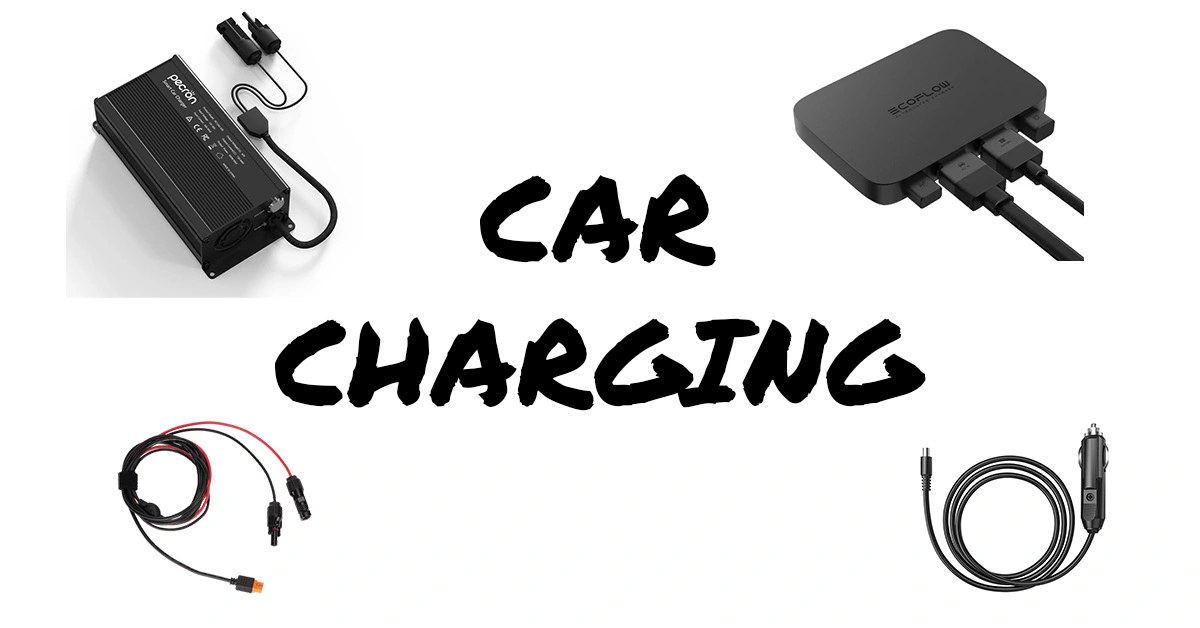There’s nothing quite like bringing a portable power station along for the ride in your car, RV, or campervan. And while solar panels can be an excellent way to power up, sometimes you need an extra boost while on the road. That’s where power station battery chargers for cars come into play.
The classic cigarette lighter port works for some situations. But they’re pretty slow and weak. Thankfully, there are other ways to charge a power station while driving.
In this guide, we’ll show you how to harness your car to recharge your portable power station with a lot more power. Let’s go over the best ways to recharge your power station with your car.
We carefully select the products and services we link to. If you buy through our links, we may earn a commission. There’s no extra cost to you and it helps us provide this information.

Quick Overview: Six Ways
If you check out the user manual of your power station, it will likely say there is one way to charge from a vehicle. The 12V cigarette port. But that’s not really true.
We’ve uncovered at least six different power station battery chargers for cars, including:
- Cigarette Lighter Port: Easy but very low power and slow
- Bluetti 560W Alternator Charger 1: Universal car charger with adjustable voltage MC4 output
- EcoFlow 800W Alternator Charger: Perfect for EcoFlow power stations
- Pecron 500W DC Car Charger: Universal charger with preset output voltage through MC4 connections
- Boost Converter & Isolator: Customized wiring to get the voltage your power station needs
- AC Inverter: An alternative way to get power but more inefficient
There are many ways to use your car to charge your power station.
Note: If you are looking for a way to charge your car’s battery with your power station. You can get a simple male cigarette lighter to alligator clamps cable. The EcoFlow Alternator Charger can also do this.
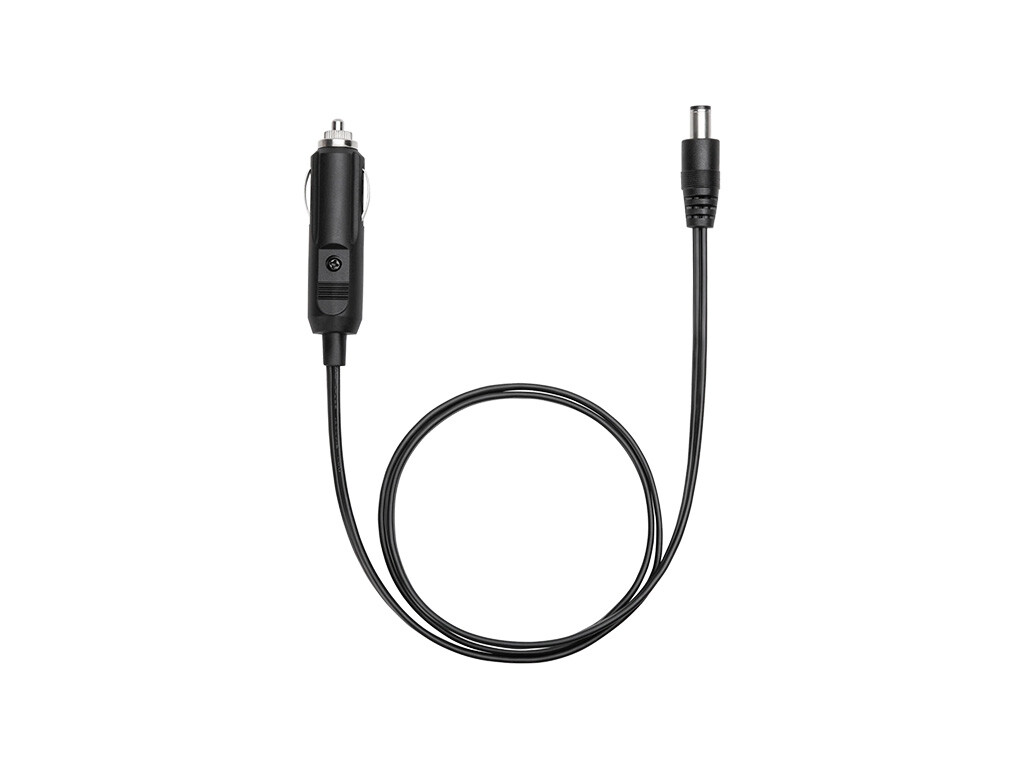
Cigarette Lighter Port: 12V DC Car Charger
The easiest way to charge your power station using your car is through the cigarette lighter port. Most power stations come with the right adapter. Just plug it into the port and power station. Done and done.
So what’s the problem?
The problem is a lack of power. Most of these ports offer only 120W maximum. It can work for compact power stations, but if you have a mid-size power station like the Jackery 1000 v2, EcoFlow Delta 2, or Bluetti 180T, it will take 10 hours or more to recharge the battery from your cigarette port. It’s far from ideal.
Here’s how to figure out how long it will take to charge your power station from the cigarette lighter port:
- Divide your power station battery watt-hours (Wh) by 120W (assuming your car is 12V with a 10A outlet)
- Add about 20% due to expected inefficiencies and the power station BMS protection measures
- The result is how many hours it will take.
For example, the EcoFlow Delta Pro 3 has a battery that is 4,096Wh. 4,096Wh divided by 120W is about 34 hours. Add in another 20% to get about 41 hours for a cigarette lighter port to recharge the Delta Pro 3. You’re better off relying on solar panels compatible with the Dela Pro 3. Or the EcoFlow Dual Fuel Generator.
Overall, the cigarette lighter port is the most straightforward power station battery charger for cars. But it’s slow and not great if you want to recharge quickly or get a lot of power out of your car.
| Charging Method | Car Cigarette Lighter Port |
| Est. Maximum Wattage | Usually 120W |
| Best For | Small power stations |
| Advantages | Easy and commonly available |
| Limits | Limited power and very slow charge rate |
| How To | Simple adapter plug |
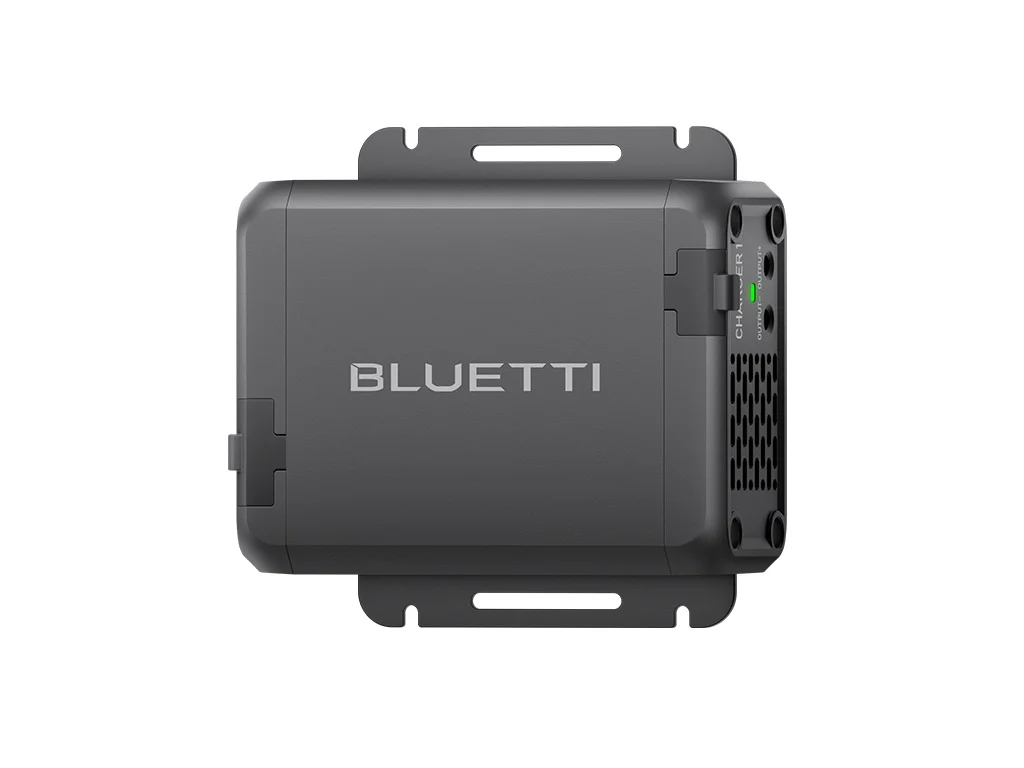
Bluetti 560W Alternator Charger 1: Universal & Adjustable
Our current favorite way to charge a power station from your car or RV is the Bluetti Charger 1. It’s a high-powered charger built with universal connections and the right settings to use it on the vast majority of power stations.
If you’re looking for the best car charger to use with any power station, this is it.
The things we like about the Bluetti 560W Alternator Charger 1 include:
- High-powered output with up to 560W pulled from your vehicle’s electrical system
- Adjustable voltage output can work with a variety of power stations, matching the allowable voltage through the solar input
- Utilizes common MC4 connectors to work with nearly any power station, just like solar panels.
What this means for you is that this Bluetti car charger is ready for action. It mimics a solar panel output. One thing you have to watch out for when connecting any solar panel is the voltage limit. You cannot exceed the voltage limit of a power station.
Bluetti is fully aware of this. And while the Pecron 500W Charger below offers a similar MC4 connection, Bluetti’s adjustable voltage means it can work with a lot more power stations. You can change the voltage output of the Alternator Charger 1 to match your power station’s maximum voltage input (as listed for the solar input).
You can even use this with EcoFlow models. However, the EcoFlow Charger (details coming next) offers some benefits that this Bluetti doesn’t. Mainly it can reverse the power and send it from the power station to the vehicle battery. But the downside is that it uses proprietary EcoFlow connectors. This not only limits it to specific EcoFlow models, but it also means that extending the cables is a major challenge.
If you’re ready to get charging power while driving for your power station or solar generator, head over to the Bluetti Alternator Charger 1 listing today.

|
BLUETTI 560W Alternator Charger 1 |
Charger on Bluetti |
| Charging Method | Bluetti 560W Alternator Charger 1 |
| Maximum Wattage | Up to 560W |
| Voltage | Adjustable from 15V to 56V (with 12V battery) or 27V to 56V (with 24V battery) |
| Best For | Any power stations with 15V to 56V solar input |
| Advantages | Universal fit, powerful with adjustable voltage |
| Limits | Very few – excellent cross compatibility with Bluetti and more |
| How To | Connect directly to battery then use MC4 connectors (common solar connection) to power stations |
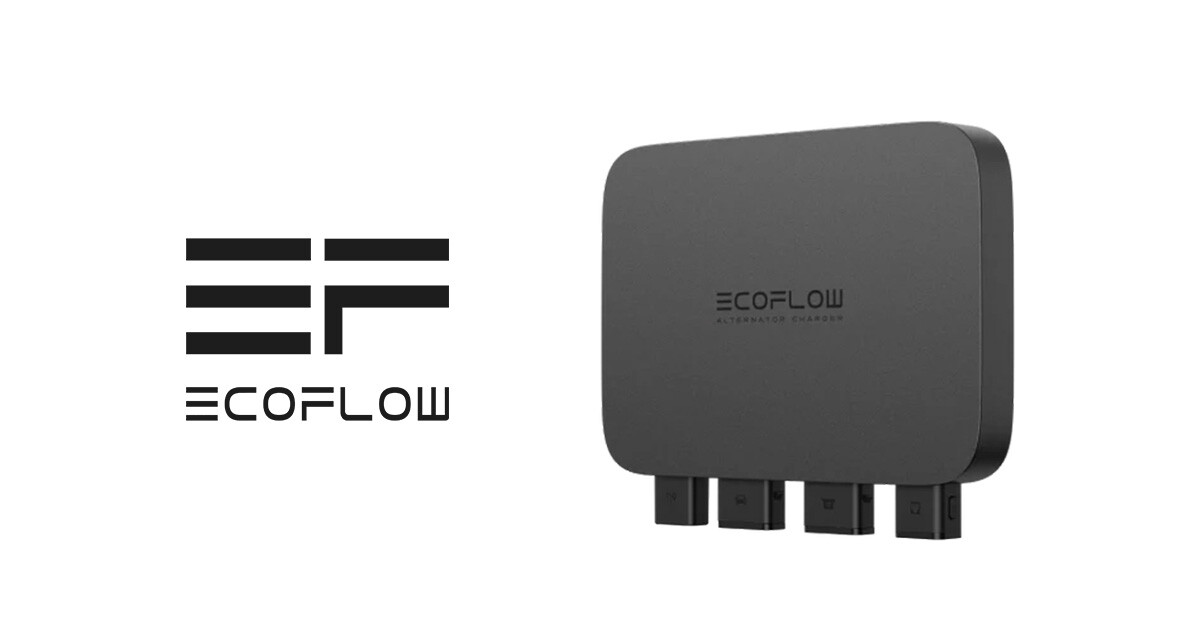
EcoFlow 800W Alternator Charger: Fast But Specific
EcoFlow is consistently a step ahead of the competition. And with the EcoFlow 800W Alternator Charger, they’ve transformed the way you can charge your EcoFlow power station from your car.
This is a high-powered solution to using your car to charge your EcoFlow power station. By directly tapping into your car’s alternator power, it can take in up to 800W and send it directly to your power station.
It also works the other way around. You can use your power station as a charger for your car too!
So what’s the catch? There are three:
- EcoFlow only: Due to a proprietary connector, it currently only works with select EcoFlow power stations.
- Price tag: This is a rather expensive charger, but that’s because it comes with a host of intelligent features.
- Cable extensions: It’s challenging to use longer cables due to proprietary connections.
If this doesn’t work for you, the Bluetti Charger 1 is our favorite alternative, even for EcoFlow power stations and others. Or keep reading to get details for the similar Pecron Car Charger with universal connections but a more limited voltage output.
For EcoFlow power users, this is an amazing product with these features:
- App Monitoring and Control: The Charger connects to your app so you can see how much it’s charging and have full control from anywhere.
- Charge Either Direction: You can use your car to charge your EcoFlow power station or reverse the flow to use your EcoFlow to charge just about any 12V battery.
- Intelligent Charger: Smart software and monitoring allows the EcoFlow 800W Alternator Charger to automatically stay within the limit safe for your vehicle and power station.
- DC to DC Solution: This is a highly efficient and incredibly powerful DC to DC charger
- Easy Installation: Connects directly to your car or RV battery, then uses provided cables and connectors to connect to the EcoFlow power station. If you don’t want to do it, any stereo installer or RV tech should be able to.
For more details, head over to our full post on the EcoFlow 800W Alternator Charger.
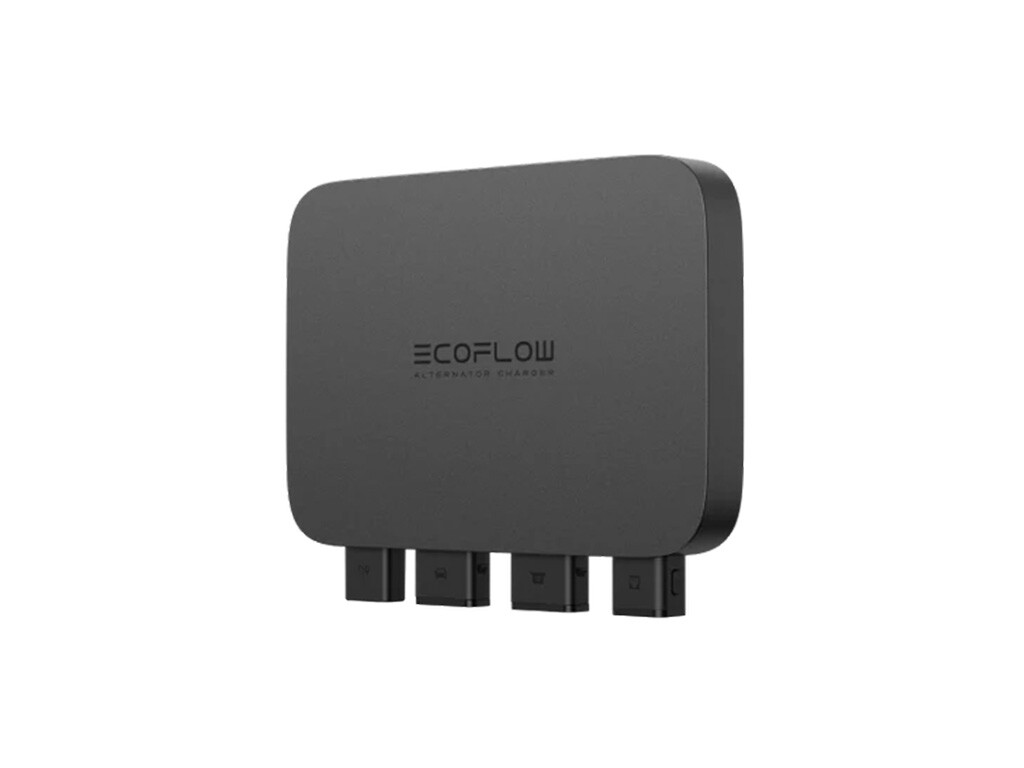
|
EcoFlow 800W Alternator Charger |
EFAC on EcoFlow Buy on Amazon |
| Charging Method | EcoFlow 800W Alternator Charger |
| Est. Maximum Wattage | Up to 800W |
| Best For | Select EcoFlow power stations |
| Advantages | Powerful and intelligent |
| Limits | EcoFlow only |
| How To | Connect directly to battery then use proprietary connectors to EcoFlow power stations |
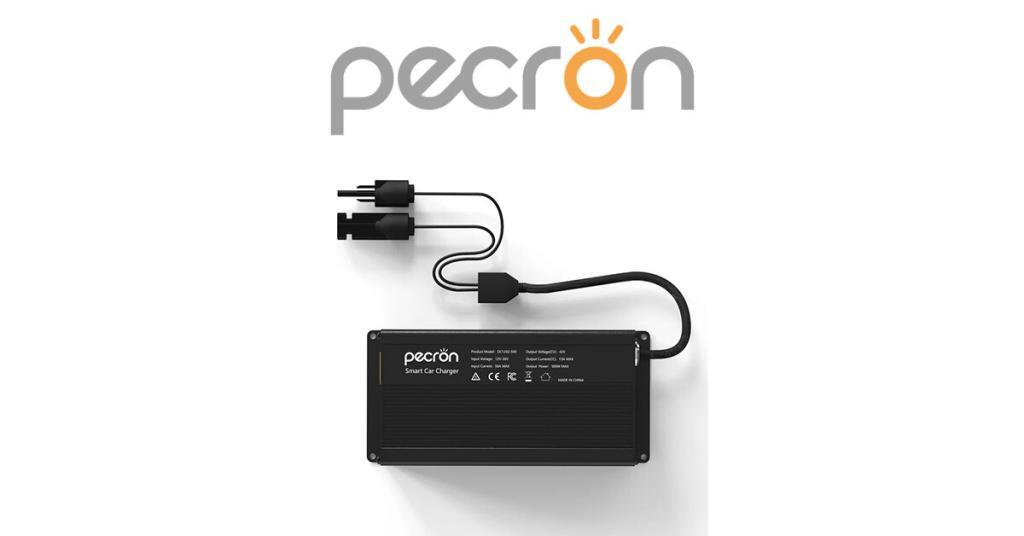
Pecron 500W DC Car Charger: Universal and Ingenious
Pecron has introduced a way to recharge any power station from a car. The Pecron 500W Car Charger connects to your car on one side and the solar input of your power station on the other. The result is a fast, affordable car charger for almost any power station.
This innovative device is made possible by an ingenious design choice. Just like the Bluetti Charger 1, the output side of this car charger uses MC4 connectors, the same ones found on the vast majority of solar panels. And in many ways, the output is nearly identical to what would come off of solar panels.
So your power station can connect to this and it will think a set of solar panels is connected to it!
Almost every power station company offers a way to use MC4 connectors with your power station. Just identify what the solar input connector is, then get an MC4 adapter for that plug. Here are some top examples:
- EcoFlow MC4 to XT-60 Solar Charging Cable
- Bluetti Solar Charging Cable MC4 to 8mm
- Bateria Power MC4 to XT60 Cable 10ft (universal for any power station with an XT-60 port)
Once you have this cable, you just connect the Pecron Car Charger to your vehicle’s battery, then plug the other end into your power station. Set the voltage and you’ll be all set.
The only thing to watch out for is the voltage output of the Pecron power station car charger. Just like with figuring out how many solar panels you can connect, you must stay within the power station’s voltage limits for the solar input. The Pecron dishes out 42V, so if that’s within your power station’s solar input capability, you’re good to go.
That’s the major advantage of the Bluetti Alternator Charger 1. It offers adjustable voltage output that can match a wider variety of power stations.
Want to verify your specs? Check out our comparison charts for EcoFlow, Bluetti, and Jackery power stations. They have the details you need.
Not only is this Pecron DC to DC Charger a great universal choice, it’s also priced very well.
This 500W charger can charge a 1,000Wh battery in about 2 hours. That’s a very fast charging rate. If you have a smaller 300Wh power station, you can get a full charge in a short drive less than an hour. It’s also not too tough on your vehicle, only pulling up to 50A (at most).
For more details, check out our full article on the Pecron 500W Car Charger.

|
PECRON 500W Car Charger for Cars, RVs, etc. |
Buy on Pecron |

|
Nuofany MC4 to XT60 Adapter Connector 24in |
Buy on Amazon |

|
JacEnergy MC4 to 8mm Adapter Cable |
Buy on Amazon |
| Charging Method | Pecron 500W DC Car Charger |
| Est. Maximum Wattage | Up to 500W |
| Best For | EcoFlow power stations |
| Advantages | Powerful and intelligent |
| Limits | EcoFlow only |
| How To | Connect directly to battery then use proprietary connectors to EcoFlow power stations |
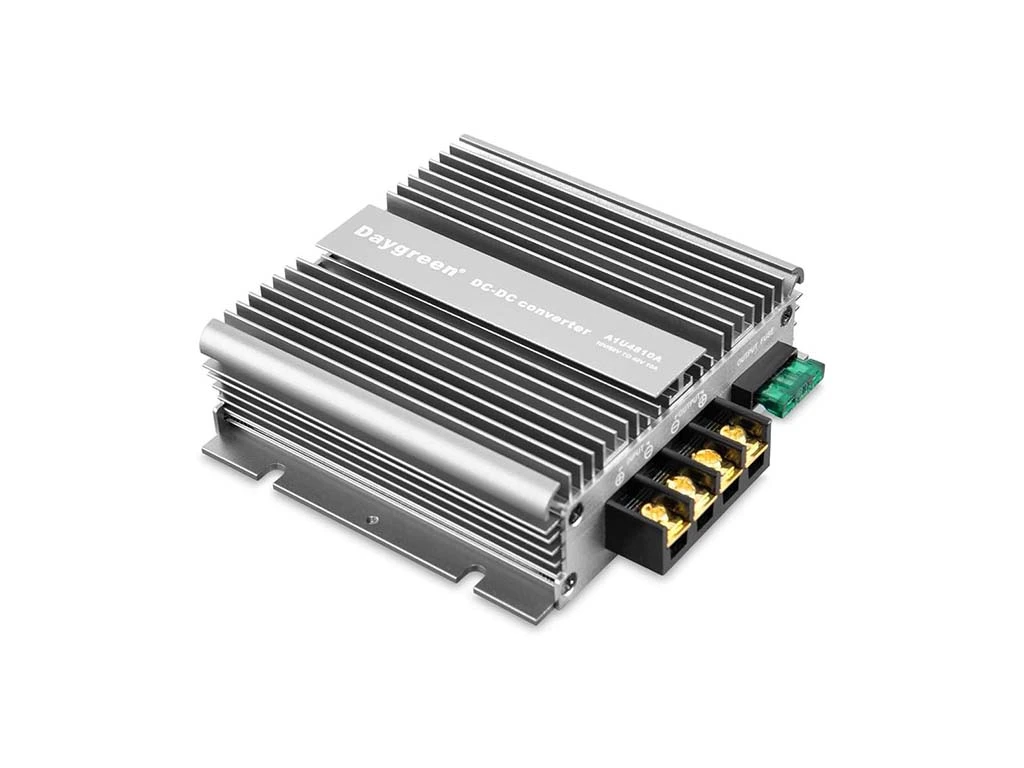
Boost Converter and Isolator: Custom Crafted
For most off-grid batteries, you can use almost any DC to DC charger to take advantage of your car’s electricity. Which can make you wonder why you have to use such specialized equipment for power stations? After all, they have a charge controller built in.
Can you connect the car battery straight to the power station?
Most experts agree that it’s not a good idea to connect your car’s battery (or any battery) directly to the charging inputs of a power station. The energy should be provided to the power station in a controlled manner to avoid causing serious problems. And a DC to DC charger isn’t ideal because then you plug a charger into another charger.
But there are ways to make it work with your own designs and products. It basically just comes down to pulling the energy off your car and making sure it’s provided to your power station in a controlled manner at the right voltage and current (amps).
There are many different ways to do this, but it usually has these parts:
- Step Up Voltage Boost Converter: To get a fast recharge rate, increase the voltage so you can reduce the amps. Watts = volts x amps.
- Isolator: Allows you to control when the power station uses the car’s energy and provides safe separation from the rest of the vehicle.
- Ring Terminal Connectors: To connect to the car’s battery.
- Appropriate Gauge Wire: Verify your cable matches the current and length (follow this BlueSea chart).
- Fuse(s): Make sure to appropriately fuse the connections where necessary.
- Power Station Adapter: Use the right adapters to plug into your power station’s DC input.
As you can tell, this is a much more complicated DIY solution that requires some careful planning. We recommend consulting with a professional if you don’t have the knowledge to do this on your own. Here’s a video walkthrough of one installation:
What you want to look for is a boost converter that changes 12V (or whatever your vehicle’s battery is) to a higher voltage that meets your power station’s solar input. It must fall within the power station’s solar input.
Our recommended choices for step up boost converters are:
- Victron Energy Orion 480W DC-DC Boost Converter 24V 20A: High quality company but not that high of voltage. 20A may be too much for many power stations, which is fine, it just won’t be absorbed. It also means you must use larger wire gauge to handle higher current.
- Daygreen 480W DC-DC Step Up Boost Converter 48V 10A: Excellent specs with a voltage many power stations can take. The low 10A is ideal and means you can use pretty small gauge wire.
- Daygreen 960W DC-DC Step Up Boost Converter 48V 20A: A more powerful option that can be good for vehicles with a powerful alternator. For some vehicles, this is too much power to pull off (960W on a 12V system is 80A).
In general, this is a good route to go if you know a lot about electrical components and are confident you can turn your car’s 12V into an output your power station can handle.
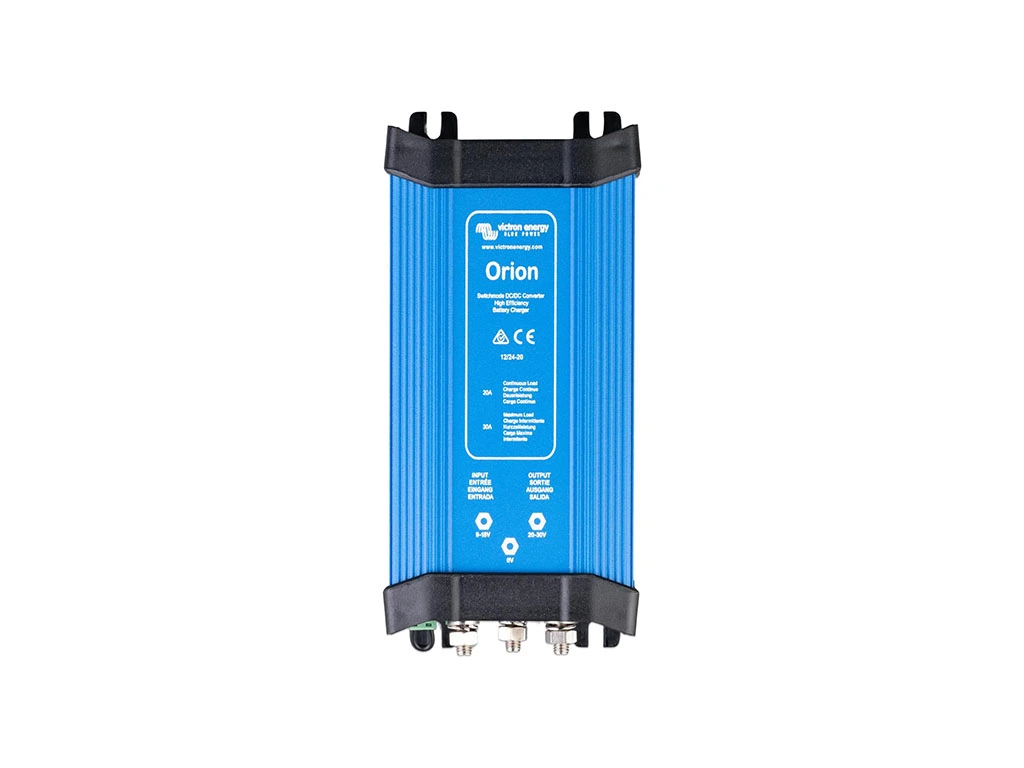
|
Victron Energy Orion 480W DC-DC Boost Converter 24V 20A |
Buy on Amazon |

|
Daygreen 480W DC-DC Step Up Boost Converter 48V 10A |
Buy on Amazon |
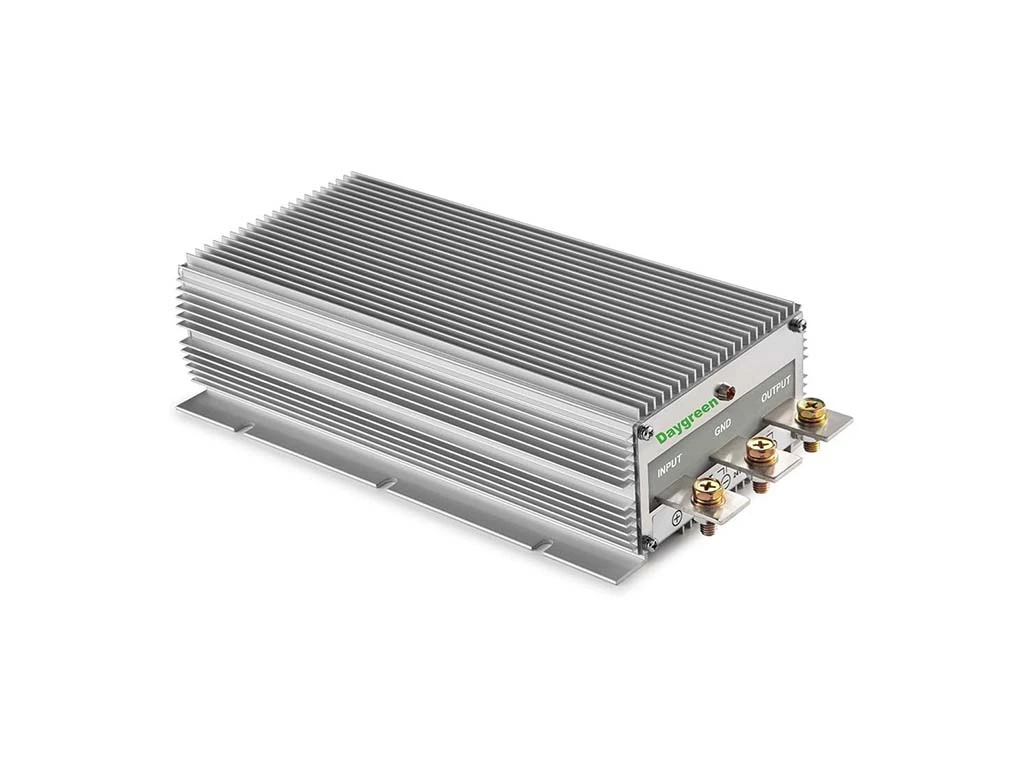
|
Daygreen 960W DC-DC Step Up Boost Converter 48V 20A |
Buy on Amazon |
| Charging Method | Step Up Boost Converter and Isolator |
| Est. Maximum Wattage | Depends on equipment |
| Best For | Electrical experts |
| Advantages | Affordable and powerful |
| Limits | Challenging system design and proper install with more manual controls |
| How To | Select the right boost converter, isolator, cables, fuses, and other components, then connect everything from the battery to the power station |

AC Inverter: Inefficient Yet Simple
Some people opt to use an AC inverter to charge their power station. This means buying and installing a separate AC inverter in your vehicle, in addition to the AC inverter that’s built into the power station. You’re not using the power station’s inverter to charge itself.
There are quite a few problems with this route. Yet it is a relatively simple way to use your car to charge your power station.
You can use an AC inverter to charge your power station from your car by:
- Install an AC power inverter to your car’s DC battery. This creates an AC outlet that is powered by your car.
- Use that AC output to recharge your power station through the AC input.
- Your power station turns that AC back into DC and fills up the battery with it.
As you can tell from this description, there’s a lot of DC to AC and AC to DC changes happening. This shows how inefficient it is. Your car’s battery is DC and the power station’s battery is DC. Using an AC inverter as a charging source is problematic.
The other issue is that you need to buy another inverter just to charge your power station, which already has an inverter.
And one final issue is that you might be tempted to get a high watt inverter to charge your power station quickly. But you have to be careful with how much power you pull from your car. A 1000W inverter would pull well over 80A from the car.
BougeRV makes a solid 2,000W inverter, but that is probably more than you’d want to pull from most alternators.
Having said all of that, this can be a way to charge your power station while driving. It may not be the most elegant or efficient, but if you already have an inverter laying around and know how to safely connect it to your car, then it’s a good choice.

|
BougeRV 2000W 12V Pure Sine Wave Inverter |
Buy on BougeRV |
| Charging Method | AC Inverter |
| Est. Maximum Wattage | Depends on equipment |
| Best For | Those who don’t mind inefficient and redundant systems |
| Advantages | Adds an AC charging source in your car |
| Limits | Inefficiencies caused by changing DC power to AC just to go back to DC; expensive inverter when power station already has one |
| How To | Select the right inverter, cables, fuses, and other components, then connect everything from the battery to the power station |
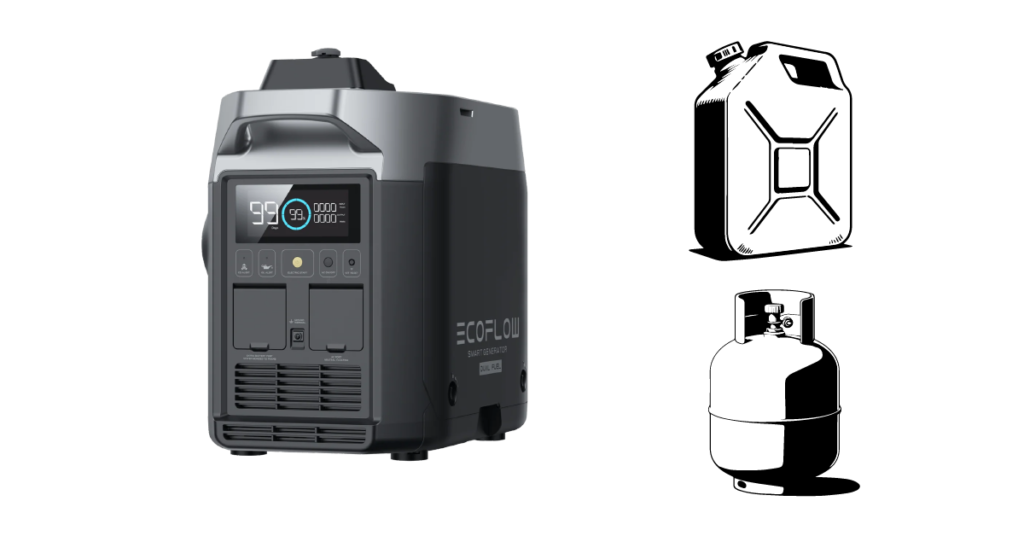
Bonus Charging Source: Fuel Generator
This one isn’t technically a way to charge your power station from your car. But it’s another useful way to charge without solar or any other power source.
A fuel generator might be a better solution for many people than using the car. If you want to charge your power station WITHOUT driving, then using a small fuel generator is much more efficient than turning on your vehicle’s large engine. No matter how much energy you pull from the alternator, your car’s engine is designed to move an entire vehicle and it will use a lot more fuel than the energy the alternator gives off.
So if you’re going to be at a campsite and think solar might not cut it, consider getting a small fuel generator.
The best part is that as soon as you turn on the fuel generator, the power station will absorb all of the energy it gives off. Then you can quickly recharge the battery and put the fuel generator away.
For example, a 2,000W Fuel Generator can mostly recharge a large 2,000Wh battery in one hour. That’s a lot of power to have so quickly.
A fuel generator is a good backup charging source for a power station because they:
- Provide a lot of power in an short time
- Can connect and quickly recharge the power station without wasting energy
- Are affordable and can use many types of fuel
For EcoFlow users, the EcoFlow Dual Fuel Generator is a superb option. It has fast DC charging, can use gasoline or propane, and connects to an app for remote starting and control. With the right power stations, like the Delta Pro and Delta Pro 3, it can automatically detect the battery level.
The EcoFlow Generators can be used for other power stations through the AC output. But if you don’t care for the smart features and remote control, the Pulsar 2,200W Portable Dual Fuel Generator is a great choice.
You can read more about how you can create a Dual Solar and Gas Generator. Or you can understand the differences between Solar Generators and Gas Generators here.
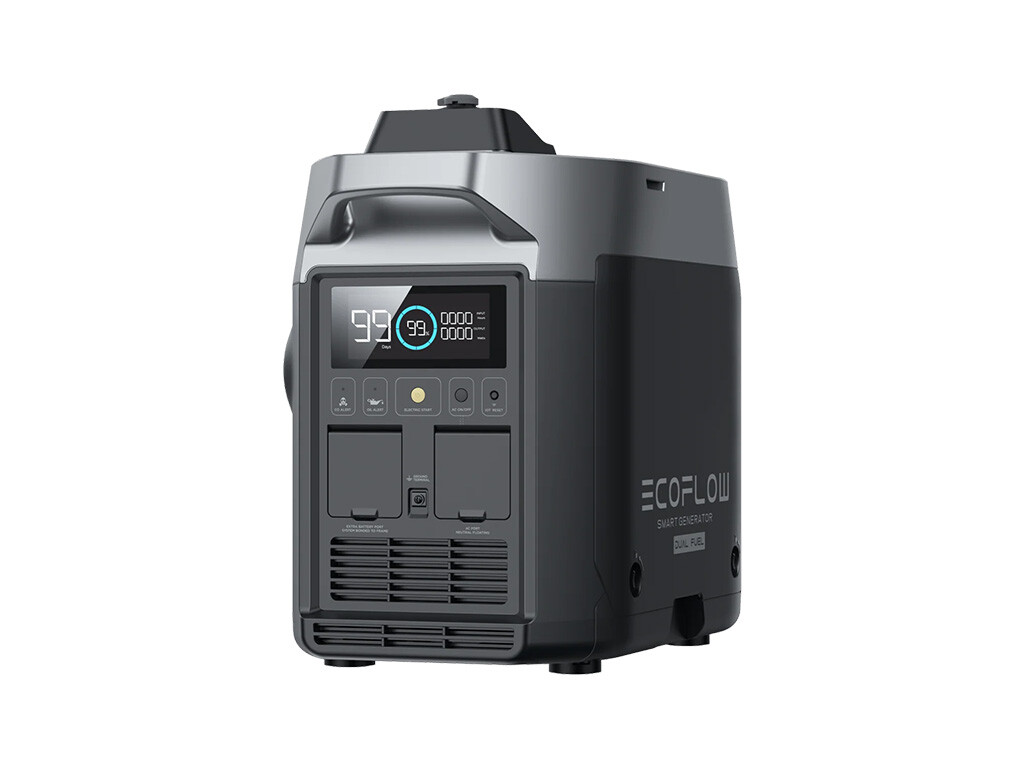
|
EcoFlow Dual Fuel Smart Generator |
DFSG on EcoFlow Buy on Amazon |
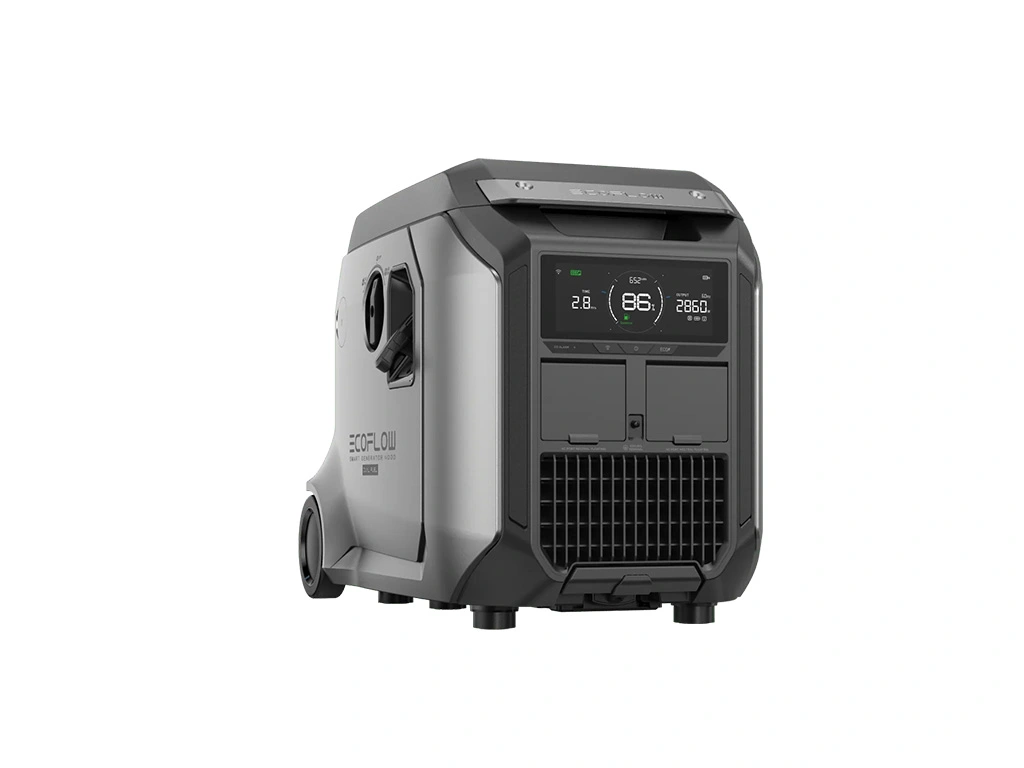
|
EcoFlow Smart Generator 4000 (Dual Fuel) |
4kWSG on EcoFlow |
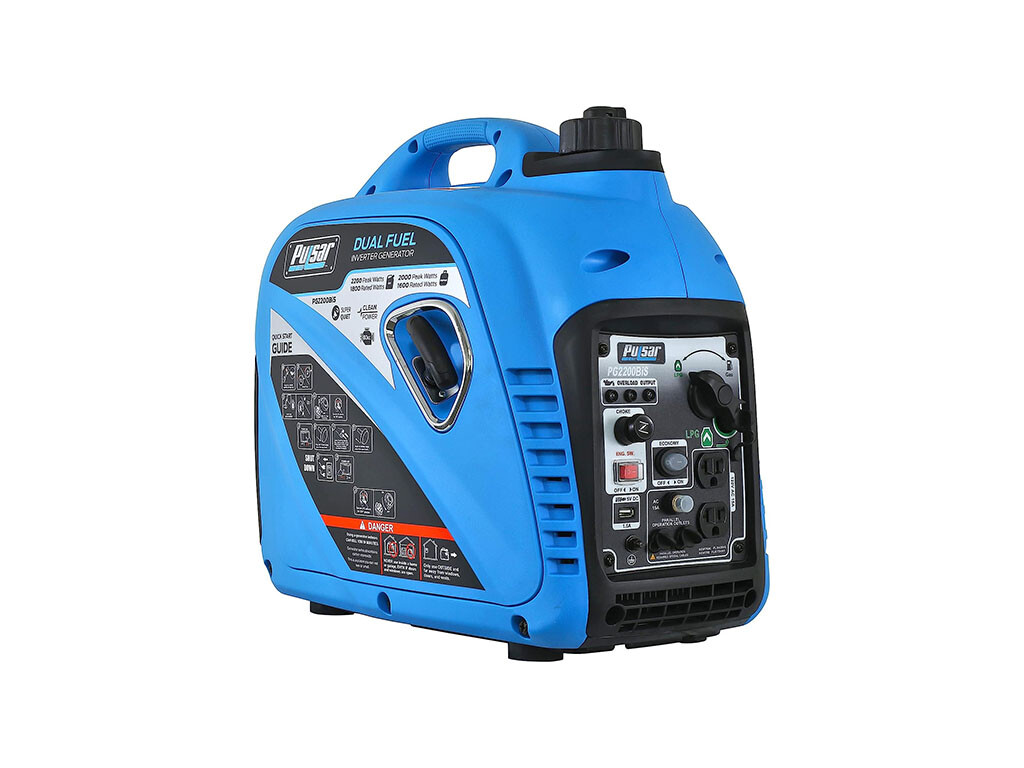
|
Pulsar 2,200W Portable Dual Fuel Generator |
Buy on Amazon |
| Charging Method | Fuel Generator |
| Est. Maximum Wattage | Depends on equipment |
| Best For | Off-grid charging without car or solar |
| Advantages | Powerful, affordable, don’t need car running |
| Limits | Noisy, need maintenance, some may require AC inverter |
| How To | Get fuel generator, connect it to power station, turn it on to quickly recharge battery |
Power Station Car Charging: Tips and Tricks
This guide has provided a lot of ways to keep your power station running while away from home. In this part, we’ll review some of the general tips and tricks you should know.
Using Solar Input
It might be confusing, but the way that you can use your car to charge your power station often uses the solar input. Why is that?
It’s because the solar input isn’t just a solar input. It’s a DC input. And solar panels are not the only thing that have DC power. Your car does too! So can a lot of other power sources.
Every power station has a unique solar DC input, with specifications that you should be aware of:
- Watts: This is the most advertised spec of the solar input, showing the maximum charging rate the solar input will accept.
- Volts: This is actually the MOST IMPORTANT spec to pay attention to. Any DC source you connect MUST fall within the voltage range of the power station’s input. If you exceed it, you can cause serious problems. It it doesn’t meet the minimum voltage, it won’t charge.
- Amps: This is the current and generally speaking, it’s not a big deal to go over this. With car charging sources, you want to make sure you don’t go over your alternator’s amp limits. Anything extra you feed to the power station just won’t be absorbed.
If you follow these specs, you can connect just about any DC power source to your power station.
Alternator Limits
Using your car as a charging source means you’re pulling extra electricity from the alternator. Every combustion engine vehicle has an alternator. It is connected to the engine through a belt. As the engine spins the belt, it also spins a pulley that’s connected to the alternator. And when the alternator’s pulley spins, it generates electricity that’s used to charge your car’s battery and power electronics.
Alternators vary in their capability. And car manufacturers vary in how much excess power they make available.
In most cases, the larger the car and the more electronics it has, the larger the alternator will be. Fully loaded large trucks will often have a 100A to 200A alternator. If you don’t have all electric accessories on, there might be a lot of current to use to charge your power station.
Small cars can have a 60A alternator, and might be using most of the 60A to power things. That means you can’t pull a ton of energy off it to charge your power station.
You can usually check the alternator’s amp rating in your owner’s manual. Or search for a replacement one on car parts websites and they’ll show you what the OEM (original equipment manufacturer) is. You can also test your alternator with a multimeter.
In many cases, you can upgrade your alternator. And if you want to pull a lot of energy from your car to charge your power station, it can be a great idea to upgrade it. It’s much better to avoid stressing out and burning out the alternator. It is critical to keeping your car’s starter battery charged.
Battery Connection
Most of these power station chargers for cars don’t actually connect to the alternator. They use the battery connections. What is that?
This is because it’s much easier to leave one high-amp connection going to/from the battery to the alternator. Then you can run all your devices from the battery. As the devices pull electricity, it goes from the alternator to the battery (or just the terminals) and to the device. The fact that this goes through the battery or the terminals doesn’t matter. It’s still coming from the alternator.
However, this does mean that it can pull energy from your battery. Just like every other electronic in your car. Notice how everything is connected to a fuse box, then your battery? Your headlights and radio don’t connect straight to the alternator, even though they’re both powered by it.
What’s nice about this setup is that many cars have a built-in way to connect devices to the battery. Some cars have a high-amp busbar, which might have an open spot in it (especially if your car doesn’t have all options). This can provide an ideal place to connect to.
And even if there’s no built-in busbar, you can still use simple ring terminals to connect to most batteries. If your battery doesn’t have ring terminals, there’s a good chance that an auto parts store will have the terminal ends needed to connect a cable to the batteries. This is a very common need to add anything from extra lights to upgraded stereos. Basically any electronic upgrade will need to connect to the battery.
Installation Techniques and Help
If you are familiar with DC circuits and car electronics, running the single set of cables for a power station charger is usually a piece of cake that’s done in an hour or two. The hardest part is finding a good way to run and hide the cable from the battery to the location of the charger.
But if you aren’t so knowledgeable about creating a DC circuit, you don’t have to do this.
Connecting a power station charger for cars is very similar to connecting just about any other electronic to a vehicle, like an amplifier. If you can share the spec sheet with them (so they can read the amps/current) and tell them what you want, nearly any stereo installer or RV technician should be able to help out. Even a lot of general mechanics might do it, if they work on electronics.
It’s really just about connecting the wire that’s usually provided (like the EcoFlow, Bluetti, and Pecron) and running it from the battery, through the firewall, and to the location of choice. It usually needs a fuse too. The firewall of many vehicles already have existing holes you might use.
Also, keep in mind that the charger itself may need a little ventilation. If you get a high-amp one, it will have a lot of current going through it. This can cause heat buildup. Don’t overlook the venting needs.
Bottom line: Be careful and don’t get in over your head. This is an easy job for the right person, so if you aren’t confident, ask a pro for help. Always carefully review the manufacturer’s warnings and installation tips. And when designing your own system, use extreme caution. It doesn’t hurt to keep a fire extinguisher around too. You can also use a cutoff switch to make sure the car charger is completely disconnected when not in use.
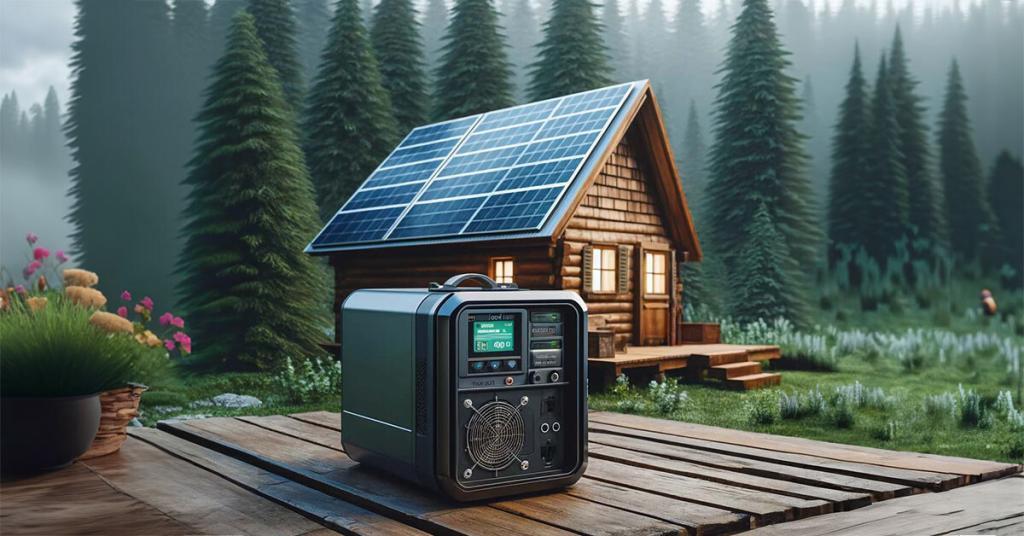
Wrap Up: Power Station Battery Charger for Car
If you want to hit the road and keep your power station charged up, there are many different ways to get the job done. The Pecron 500W DC Car Charger or Bluetti Alternator Charger 1 are our top options, but you can also use the basic cigarette lighter or even a fuel generator if you want.
- Interested in other off-grid energy sources? Learn about the ways for How to Generate Off-Grid Electricity.
- Are you using the power station just to charge your phone while camping? There are other solutions.
- Adding solar power to an RV or campervan has never been easier. Check out the Best Solar Generators for RVs and Vans.

